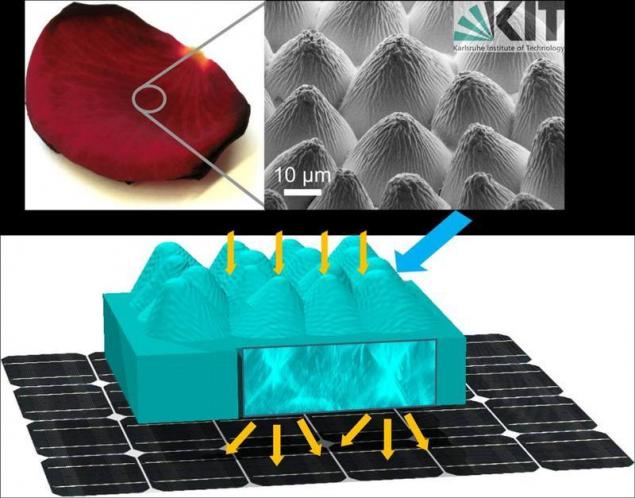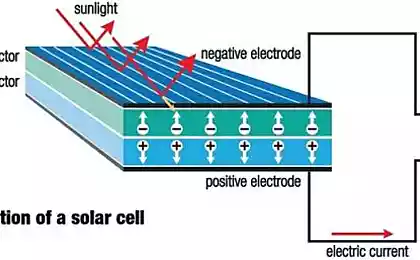709
Rose petals made solar panels more efficient
The surface of the solar cell, which resembles the petals of a flower, can improve their light-absorbing capacity and thus allow them to generate more power, say researchers at the Karlsruhe Institute of Technology (KIT) in Germany. Scientists have reproduced the cells of the epidermis of rose petals, which have a particularly good anti-reflective properties in a transparent material, which are then inserted into the organic solar cell. An article on this was published in the journal Advanced Optical Materials.

Like plants, solar panels absorb light energy and convert it to another form. In order to do this effectively it is important to use a large part of the light spectrum and capture the light coming from different angles of incidence due to changes in position of the sun. In the course of evolution, plants have learned to do it, that is sufficient reason to scientists carefully studied natural objects in the development of solar cells with a broad spectrum of absorption and ability to catch the light at different angles of his fall.

So scientists at the KIT and the Center for Solar Energy and Hydrogen Research (ZSW), also in Germany, decided to investigate the optical and anti-reflective properties of epidermal cells in different plant species. These properties are particularly pronounced in the petals of roses, where they provide a strong color contrasts and thereby increase the likelihood of pollination. Studying the epidermis rose petals with an electron microscope, scientists have discovered that it is composed of densely packed informal arrangement of microstructures, with additional edges formed by randomly arranged nanostructures.
In order to obtain a synthetic analogue of this structure, scientists first created negative impression shapes epidermis "polydimethylsiloxane" silicon-based polymer, and then printed in the form of a transparent optical adhesive, which then hardens under UV light. "This simple and cost-effective method of creating microstructures depth and density, which are difficult to be achieved by artificial methods," - says Guillaume Gomard of KIT
.
The researchers then integrated with the surface of the print petal roses in organic solar cells, increasing cell energy conversion efficiency of 12% for vertically incident light. At very shallow angles of incidence increase in efficiency was even higher. Scientists attribute this increase primarily excellent anti-reflective properties of the surface of rose petals, which are able to reduce the reflection from the surface to below 5% even when light is incident at an angle of almost 80 °.
"Our method is applicable both to other plant species, as well as other PV technology," - explains Gomard. - "Since the surface of the plants have multifunctional properties, it could be in the future to use several of these properties for the problem."

Like plants, solar panels absorb light energy and convert it to another form. In order to do this effectively it is important to use a large part of the light spectrum and capture the light coming from different angles of incidence due to changes in position of the sun. In the course of evolution, plants have learned to do it, that is sufficient reason to scientists carefully studied natural objects in the development of solar cells with a broad spectrum of absorption and ability to catch the light at different angles of his fall.

So scientists at the KIT and the Center for Solar Energy and Hydrogen Research (ZSW), also in Germany, decided to investigate the optical and anti-reflective properties of epidermal cells in different plant species. These properties are particularly pronounced in the petals of roses, where they provide a strong color contrasts and thereby increase the likelihood of pollination. Studying the epidermis rose petals with an electron microscope, scientists have discovered that it is composed of densely packed informal arrangement of microstructures, with additional edges formed by randomly arranged nanostructures.
In order to obtain a synthetic analogue of this structure, scientists first created negative impression shapes epidermis "polydimethylsiloxane" silicon-based polymer, and then printed in the form of a transparent optical adhesive, which then hardens under UV light. "This simple and cost-effective method of creating microstructures depth and density, which are difficult to be achieved by artificial methods," - says Guillaume Gomard of KIT
.

The researchers then integrated with the surface of the print petal roses in organic solar cells, increasing cell energy conversion efficiency of 12% for vertically incident light. At very shallow angles of incidence increase in efficiency was even higher. Scientists attribute this increase primarily excellent anti-reflective properties of the surface of rose petals, which are able to reduce the reflection from the surface to below 5% even when light is incident at an angle of almost 80 °.
"Our method is applicable both to other plant species, as well as other PV technology," - explains Gomard. - "Since the surface of the plants have multifunctional properties, it could be in the future to use several of these properties for the problem."
Israeli startup creates electric vehicle with internal combustion engine-generator
Volata - elektrobayk with built-in charging system
























